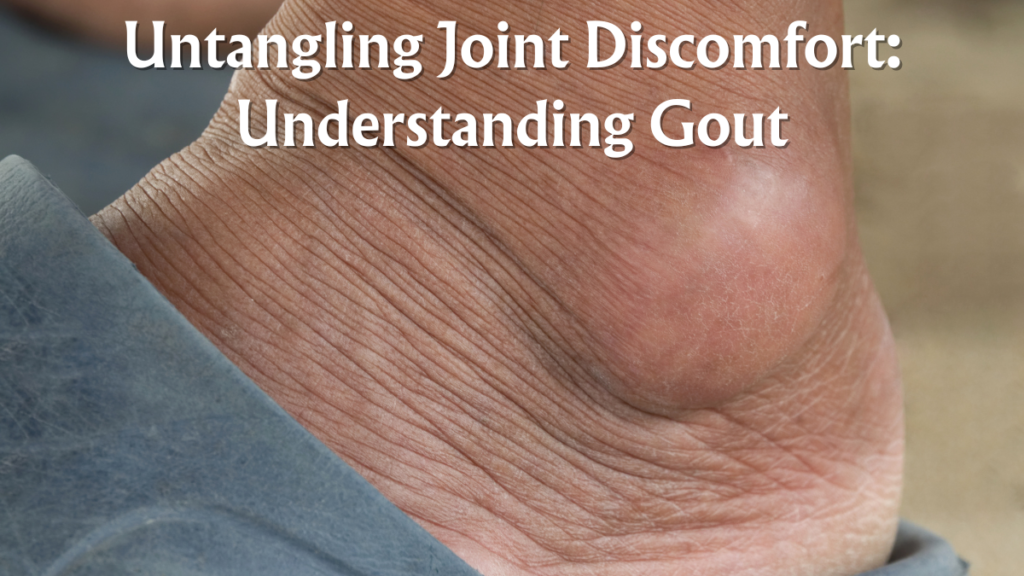Untangling Joint Discomfort: Understanding Gout, Exercise for Managing Gout
In this comprehensive exploration titled Untangling Joint Discomfort: Understanding Gout, we delve into the complexities of gout, a common yet often misunderstood form of arthritis. This piece unravels the causes, symptoms, and treatment options associated with gout, shedding light on how it affects the joints and impacts daily life.
By breaking down the science behind uric acid buildup and its role in triggering painful flare-ups, this guide offers readers a clear understanding of how to manage and prevent gout. Whether you’re someone dealing with joint discomfort or simply looking to expand your knowledge on the subject, this article provides valuable insights to help you navigate the challenges of gout with greater confidence.
Arthritis comes in various forms, and Gout stands out as a unique type caused by the buildup of uric acid in the joints. Let’s delve into the intricacies of Gout, exploring its characteristics, causes, and avenues for support and management.

Gout: Navigating the Pains of Uric Acid Accumulation
– Definition:
Gout is a form of inflammatory arthritis characterized by sudden, severe attacks of pain, swelling, redness, and tenderness in the joints.
– Cause:
Elevated levels of uric acid in the blood, lead to the formation of urate crystals in joints and surrounding tissues.
– Risk Factors:
– Genetics and family history.
– Diet high in purines (found in certain foods and beverages).
– Certain medical conditions and medications.

– Symptoms:
– Intense joint pain, often affecting the big toe.
– Swelling, warmth, and redness in the affected joint.
– Limited range of motion during flare-ups.
– Diagnosis: Blood tests for uric acid levels, joint fluid analysis, and imaging studies.
– Management:
Medications to manage pain and inflammation, lifestyle changes, dietary modifications, and, in some cases, medications to lower uric acid levels.
Navigating Joint Wellness:
– Hydration:
Adequate fluid intake helps flush out uric acid from the body.
– Dietary Changes:
Limiting purine-rich foods, such as organ meats and certain seafood, can be beneficial.
Hope Amid Complexity:
– Lifestyle Modifications:
Adopting a healthy lifestyle, including maintaining a healthy weight and regular exercise, can contribute to managing Gout.
– Patient Education:
Understanding triggers and managing stress can aid in preventing Gout flare-ups.
Exercise for Managing Gout
Here’s an exercise section you can include in your blog post titled Untangling Joint Discomfort: Understanding Gout (2024):
While gout can be incredibly painful, staying active is essential for maintaining joint health and overall well-being. Here are some gentle exercises designed to help manage gout symptoms and improve mobility:
1. Ankle Circles
– How to Do It: Sit comfortably in a chair with your feet flat on the ground. Slowly lift one foot off the ground and rotate your ankle in a circular motion. Do 10 circles in each direction, then switch to the other foot.
– Benefits: This exercise helps to improve circulation and maintain flexibility in the ankle joints, which can be particularly beneficial during a gout flare-up.
2. Toe Stretches
– How to Do It: Sit with your legs extended in front of you. Using your hands, gently pull back on your toes to stretch the muscles in your feet and toes. Hold the stretch for 15-20 seconds and release. Repeat 2-3 times on each foot.
– Benefits: Toe stretches can relieve stiffness and improve joint flexibility, especially in the big toe, a common site for gout pain.
3. Seated Marches
– How to Do It: Sit upright in a chair with your feet flat on the ground. Lift one knee towards your chest, as if you’re marching, and then lower it back down. Alternate legs and continue marching for 1-2 minutes.
– Benefits: This low-impact exercise promotes blood flow and helps to keep your leg joints moving without putting too much pressure on them.
4. Calf Raises
– How to Do It: Stand behind a chair and hold onto the back for support. Slowly rise onto your toes, lifting your heels off the ground. Hold for a few seconds before lowering back down. Repeat 10-15 times.
– Benefits: Calf raises strengthen the muscles around your ankle and lower leg, which can help support your joints and reduce discomfort.
5. Gentle Walking
– How to Do It: Engage in slow, gentle walking for 10-15 minutes each day. Be sure to wear supportive footwear to minimize stress on your joints.
– Benefits: Walking helps maintain overall joint flexibility and can aid in weight management, reducing the strain on joints affected by gout.
Note: Always consult with your healthcare provider before starting any new exercise routine, especially if you’re experiencing a gout flare-up. These exercises are intended to be gentle and should not cause additional pain. If you experience discomfort, stop immediately and consult a medical professional.
Conclusion: Embracing Joint Comfort Despite Gout
Understanding Gout is pivotal for embracing joint comfort and addressing potential complications associated with arthritis. With a combination of medical interventions, lifestyle adjustments, and ongoing support, individuals can navigate the complexities of Gout with resilience and hope.
FAQs about Gout
1. Can Gout be cured completely?
– While Gout is a chronic condition, effective management can significantly reduce the frequency and severity of flare-ups. Lifestyle changes and medications are key components of management.
2. Are there specific foods to avoid with Gout?
– Certain foods high in purines, such as organ meats, shellfish, and certain types of fish, may trigger Gout flare-ups. Limiting these foods can be beneficial.
3. Can stress contribute to Gout flare-ups?
– Stress is considered a potential trigger for Gout flare-ups. Managing stress through relaxation techniques and a healthy lifestyle may help reduce the risk.
4. Can Gout affect joints other than the big toe?
– Gout can affect other joints, including the ankles, knees, wrists, and fingers. The big toe is a common site, but any joint can be involved.
5. Is Gout more common in men than women?
– Gout is more common in men, particularly in middle age. However, women can also develop Gout, and the risk increases after menopause.






